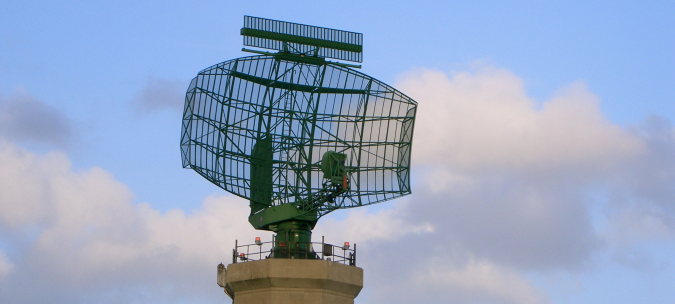Radar systems are used for many purposes, one of which is to detect and display aircraft. The radar picture is a result of the radio signals transmitted by the spinning radar antenna. Aircraft positions are determined from the direction of the antenna and the time taken for radio signals to return to the antenna.
Radar Types
 Co-located Primary and Secondary Radar.
Co-located Primary and Secondary Radar.
There are different types of radar used in air traffic control, and each has their own function. Two common types are:
Secondary Surveillance Radar (SSR)
SSR interrogates a transponder, placed aboard the aircraft. The transponder then replies to the interrogation with identity and altitude codes.
Primary Surveillance Radar (PSR)
PSR relies on reflections of radio energy from the physical structure of the aircraft. Doppler filters can be used to reject reflections from stationary objects such as terrain and static structures.
Wind turbine blades pass through the air at speeds in excess of 100 km/h. Reflections from the turning blades do therefore appear on PSR screens. In some cases returns can be similar to those from aircraft.
Detection of aircraft from PSRs can also be impaired by wind turbines – either due to desensitization or due to shadowing effects. The desensitization effect is sometimes referred to as overhead obscuration.
Determining Wind Turbine Effect on a Radar
Three important factors that determine the extent to which a particular turbine is likely to affect a radar are:
- Blade materials
- Blade shape
- Turbine height
Radar factors include:
- Transmitter power
- Receiver sensitivity
- Antenna characteristics
Factors relating to the way that the radio signals travel, or their propagation, include:
- Distance
- Terrain profile
- Earth curvature
- Refraction
- Diffraction
Assessment Method
It is necessary to determine how a wind turbine is going to affect a radar. The most common assessment methodology used is line of sight analysis which takes earth curvature and standard atmospheric refraction into account.
Line of sight calculations can be carried out with software and can be performed for specific turbine locations (see example below) or for a wind farm area.
 One of our Radar Line of Sight Assessment Calculation Chart.
One of our Radar Line of Sight Assessment Calculation Chart.
Mitigation Solutions
Mitigation solutions reduce the overall operational impact of the wind turbine by acting on one or more of the elements below:
Radar Operator
Impact can be reduced on the radar operator through solutions such as
- The reclassification of air space
- Changing air traffic patterns
- Operator training
Display
- Radar returns from wind turbines can be blanked, so they will not show up on the screen used by the operator
- Additional radar sources can be displayed
- Multiple radar pictures can be combine
- Tracking algorithms can be changed
Radar Installation
- Detection processes can be upgraded
- Antenna can be tilted
- Granularity can be increased
- Beam switching thresholds can be changed
- Tracking algorithms can be changed
- Additional or upgraded radar can be provided
Radio Signal Propagation
- Layout can be changed to move wind turbines out of sight of the radar
- Intervening buildings and trees can be measured so turbines can be hidden or shielded from radar – (click to see a short guide to wind turbine radar shielding)
Turbine
- Turbine height can be reduced
- Turbine can be repositioned
- Turbines can be aligned or spaced differently
- Blades made of radar absorbent materials, also known as “stealth” blades. This has recently been adapted by developers of a French wind farm.
Evaluation
Many mitigation techniques are being considered by various organisations. Examples that have actually resolved issues are:
Radar Operator
There are many instances throughout the world where operators continue to work effectively with wind turbines affecting radar.
Display
- Radar screens have been upgraded to accommodate the effects of wind farms.
- Inputs from multiple radar have been combined into a single picture to resolve wind farm effects. This is sometimes known as data fusion or multiple radar tracking, and this option was used in the mitigation of Whitelee wind farm.
Radar
- Individual wind farms have been blanked from radar outputs.
- Non Automatic Initiation Zones (NAIZs) have been established in tracking processors. These allow the radar to display aircraft over the wind farm, whilst not showing the wind turbine radar returns.
- Some air defence radar are much less susceptible to wind turbine interference than others.
Radio Signal Propagation
- Many wind farms have had layouts optimized so that individual turbines are shielded i.e. hidden by terrain, trees and buildings.
Most wind farm interference issues are assessed on a case by case basis and the appropriate mitigation solution is usually case specific. Larger wind farms can have a larger radar impact – but can also support higher spending on radar mitigation.
